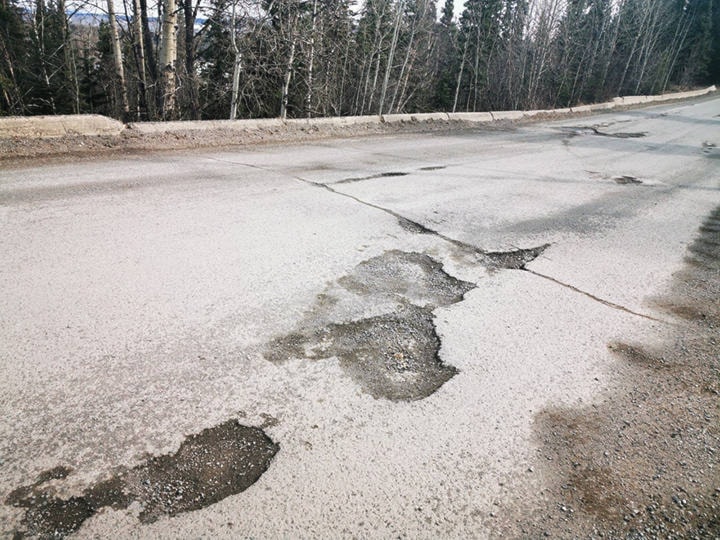The District of Houston’s roads are wearing out a faster pace than it can afford to replace or repair them.
And to meet a recommended annual road works budget of $1.5 million a year, the District would either have to raise taxes by 30 per cent or cut other services by the same amount to free up cash for the work.
These and other figures were contained in a lengthy memo from District chief administrative officer Gerald Pinchbeck in outlining the District’s financial position and the condition of its roads.
As it is, the District relies on an annual federal grant financed through gas taxes for road works and, for the past two years, a grant from the province that the District can spend as it sees fit on projects.
The federal gas tax grant for this year for Houston has been pegged at $181,000 and a plan to double that amount awaits parliamentary approval. Council will then decide how to use that additional amount, said Pinchbeck.
“While it is a welcome source of funding, there is still a sizeable funding gap to cross in order to ensure a high level of rehabilitation occurs,” he said.
Without the provincial Northern Capital and Planning Grant, which amounted to just over $6.5 million for 2019 and 2020, “the infrastructure funding deficit and rehabilitation backlog will continue to grow,” Pinchbeck added.
“Paved road surfaces typically follow a 13-15 year lifecycle, and timing of the repair/rehabilitation works determines the longevity of the base structure,” he noted in saying both paved surfaces and gravel bases require work.
The council has discussed the idea of converting the District’s rural roads to gravel or double chip-seal as opposed to asphalt as one way of addressing aging asphalt surfaces and subsurfaces.
That’s been the approach on Pioneer, Estates and Gushwa but “this is not a final decision which has been made by council and no financing was allocated towards it,” said Pinchbeck.
The comprehensive information comes as District crews prepare to start the annual effort to fill in potholes that are appearing with the arrival of spring.
A first order of 3.34 metres tonnes of repair material at a cost of $1,750 will be used immediately with another purchase planned for late summer to repair additional potholes before the next winter hits.
Last year 6.87 metric tonnes was purchased at a cost of $4,544.39 with 1.38 metric tonnes purchased in 2019 at a cost of $6,013.73, 7.6 metric tonnes at $7,526.40 in 2018, 12.8 metric tons at $12,230.40 in 2017 and 3.8 metric tons at $3,575.03 in 2016.
And beginning this year, a new tracking program introduced by the District will begin to give it annual totals of how many potholes were filled.
“Over time, this system will provide a better historical assessment for the number of potholes reported, repaired and recurring on a year-over-year basis,” said Pinchbeck.
This year the District is also asking people to report in with pothole locations so crews know where to go.
That’s resulted in an ongoing list of locations with residents generally referring to the large number of potholes being encountered every day.
For overall road repairs as part of annual operations, the District is now allocating at least $100,000 a year, a base figure that is rising to $136,100 this year and to a planned $170,600 by 2025.
The two-year Northern Capital and Planning Grant did enable the District to increase expenditures on larger projects — $608,854 in 2019 and $438,957 last year. Last year’s figure did not include money assigned from that provincial grant to the District’s major 9th Street underground and surface rehabilitation and beautification project.
